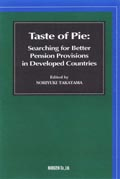Book Publications
Takayama, N., �gPension Reform: Global Solutions and Japanese Experiences,�h (Chinese Version, translated by Dr. Xinmei Wang) China Financial & Economic Publishing House, June 2023, ISBN: 9787509568170, 277p.
Hinz, R., Holzmann, R., Tuesta, D. and Takayama, N. eds., �gMatching Contributions for Pensions,�h
The World Bank, October 2012, ISBN: 9780821394922, 356p.
The use of matching contributions to enhance the participation and level of
savings in pensions system has now been in use for nearly three decades in a number of high income countries. Increasingly, countries across
the full range of economic development are looking to the design as a means of addressing the low rates of participation in formal pension
and other retirement savings systems. A number of countries have recently introduced innovations in their pension systems that significantly
rely on contributions matches and related types of direct subsidies to provide incentives for groups that mandates and other indirect methods
such as preferential tax treatment have been unsuccessful in reaching. There is particular interest among developing countries in utilizing
this design to extend coverage to informal sector and low income workers that typically do not pay income related taxes.
This volume provides descriptions and analysis of the design, experience and outcomes achieved in the high income countries where there
information about the dynamics and outcomes that this approach has achieved is not beginning to emerge. It also reviews new efforts to use
the design in a number of other settings in which the matching contributions have been included as a significant element in reform of
the pension system. The review of the experience with matching contribution across this full range of settings provides important observations
and some initial lessons for policy makers and analysts who may be considering or evaluating the use of this approach to increase pension coverage.
|

|
CONTENTS
Part I. Introduction and Conceptual Issues
1. Early Lessons from Country Experience with Matching Contribution Schemes 3
Robert Holzmann, Richard Hinz, and David Tuesta
2. Policies to Encourage Private Pension Savings: Evidence from OECD Countries 27
Edward Whitehouse
Part II. High-Income Country Experience
3. Matching Contributions in 401(k) Plans in the United States 53
Nevin Adams, Dallas Salisbury, and Jack VanDerhei
4. Riester Pensions in Germany: Design, Dynamics, Targeting Success, and Crowding-In 81
Axel Borsch-Supan, Michela Coppola, and Anette Reil-Held
5. New Zealand�fs Experience with the KiwiSaver Scheme 103
Geoff Rashbrooke
6. The Impact of Matching on Savings in the U.K. Savings Gateway Program 133
Will Price
7. Matching Defined Contribution Pension Schemes in Japan 145
Noriyuki Takayama
8. Matching Contributions and Compliance in Korea�fs National Pension Program 161
Hyungpyo Moon
Part III. Middle-Income Country Experience
9. Complementing Chile�fs Pensions with Subsidized Youth Employment and Contributions 179
Hermann von Gersdorff and Paula Benavides
10. Matching Contributions in Colombia, Mexico, and Peru: Experiences and Prospects 193
Luis Carranza, Angel Melguizo, and David Tuesta
Part IV. Developing Country Experience
11. China�fs Pension Schemes for Rural and Urban Residents 217
Mark C. Dorfman, Dewen Wang, Philip O�fKeefe, and Jie Cheng
12. Learning from the Early Experience of India�fs Matching Defined Contribution Scheme 243
Robert Palacios and Renuka Sane
13. Using Prepaid Contributions to Cover Mobile Workers in Cape Verde and Tunisia 261
Antoine Delarue
14. Thailand�fs Matching Defi ned Contribution Programs for the Informal Sector 275
Mitchell Wiener
Part V. Behavioral and Design Issues
15. Matching Contributions and Savings Outcomes: A Behavioral Economics Perspective 289
Brigitte C. Madrian
16. Implementation Issues in Low- and Middle-Income Countries 311
Robert Palacios and Mike Orszag

Noriyuki Takayama, "Pension Reform with Trust and Sustainability" (Chinese Version), published August 2012, CNY48, ISBN 978-7-208-10876-9/F�E2119
CONTENTS
�O��
�����I?�V�����v�F����A?�Njy������??�i�����ŏ��j
�c�c ���R?�V
��2�i?��?���@?�j
?���҉�?
���? ���{�F�M?�^���S�I?�V�����v�c�c�c�c�c�c�c�c ���R?�V
���́@���{����?�V���I?��
1 ����?�V���Ԏ��ߐ����
2 600��?����??�o���I?�V�����t�\
3 1998�N�x�ȍ@�I�Љ��???�S��?������??
4 ?�V����???�S�V�d�����d�Œ���?�ˏo
5 ����?�V���I���^����?�V����?�ݝِ��n��?��
6 �ĕ��z�@�����I�V���t?
���́@2004�N?�V���C���@�ēI��v���e
1 ��{��?
2 ��??�I������?�^����I�@�艻
3 ��������^?���H?�I��?
4 ?�V��?�t���y�I��?
5 ?�t���y�I�Œ�
6 ��?��??�V���I�l�I?�V��?�t�??
7 ��??�S���I?�i����?
8 ?���I��?���y
9 ��?�V??�V���I���P
10 �������I?�V��?�t����?
11 ��70?�ȏ�I�V�l??�ۓI��?�V??�V��
12 ?��?�I?�V������
13 ?��?�V�����x�I?��
14 ��X���������I?�[
15 �c���l?�V���I���P
16 ����?�V����??��??��
17 ?�V�����l�M���I����ʒm
18 ��������?�V���I���P�[�{
19 ��??�V�������I�C��?��
��O�́@?��2004�N?�V���C���@�� -- ?�����K�d�I�g?�S�I??�����v�h
1 ���N1.5��?�������E�I���?�V��?�S����??
2 �s��矐��I����?�V���I��
3 �풀�o??�s?�I�N?�l
4 ???��?�I?��
5 ��?�I���
6 ?�V����??��?�v�����ŁA�����ŁA�@�l�œI?��
7 ���t�\�@��?��
8 ��????�^?�t�I���^���I�t?
9 ����?���^���g�w�@�I���s?�S�^�s��?
10 ??�p����
11 �\�c�������ēI��?��?��?�Z��r�I����??��?�H
12 ��?�ْ�I?�V�����y�˔j50%
13 ?�t��?�I?�Z���@�z���z??
14 ?������?������
15 �k�r??����I�G????��
16 �ҋ�?��^����
17 ��?��?�I?�t?�n�N?��?��?��?
18 ??�����I�͌^?�V���˔j50%
19 �~���??�V���I?�t���y���ۍ�?
20 ?�����ŝ�����?�V��
21 �ŋ��I�Q?������
22 ?���I�]��
23 �L��??�I?�V������
24 ?��?�V������?�ƒ�I?��
25 ?�_�����I�^?
��l�� ?�V�����x�I?����v
1 ��????�^?�t���ڑ�?
2 �^?��??�����I��???
3 ����?�V����??���������^??
4 ��??�V���I���
5 ����??�V���I??
6 ������?���i�ŋ��j�p��??�^?����?�I??�o��
7 ���@20�N�I���ڗ^?�ڔ䗦�I�C��
8 ��?��?�V��?�ړI�I��?��
9 �}��?�t�I����
10 ���x�I��?
11 ���S���t�\�I��̈ė�
12 ����?�V���I??�o��?��?����
��́@���T-����???���I??
1 �����O���v?�ؓI?��
2 ���v�I�w�i�^?��
3 ����?�V�����x�I?����v
4 ��?��????
5 ??�^?�t��?��??��?�y����O
6 ?�V����???��?���Œ�
7 �ڎ�?�t�I?�n�N?�I??��������r
8 ���H??�V���I??
9 ��?���葕�u�I��?
10 ����?�V��?�t?�I�}��
11 ??�ŕ����I�ْ[�I�ᔻ
12 �^?�����?��I?�t��?�V���I��?
13 ��??�V������??�V���I??
14 �j���F�I�M
15 �c���l?�V���A?��?�V���I��?
��Z�� �����^�@��
1 ��L110�N?�j�I����?�V�����x
2 1972�N���v
3 1992�N���v
4 ?��I?�t?��
5 �ڎ�?�t?�n�i�ދx�j�N?�I��?�I��O?�{
6 ?�l�����f�I?��
7 ?�p?��?�厊??�H
8 1999�N�I���v
9 ��??��I??
10 2001�N�I���v
11 ���z��?�V���I?��
12 ����?�V����??�I?��??
13 ??���Љ�ۏ���v??��
14 �������I�V�I��?���葕�u
15 �g�ٖ@�r���I���Ɓh�I๋^
16 �@���ڎ�?�t?�n�N??60?
17 ???���Z�I�l�I????
18 �Љ�ۏ�ړI�ŁiCSG�j
19 ��??�V���iAGIRC.ARRCO�j
20 2003�N���v
�掵�� �q���A�V�����A�S�嗘?����
1 �q���I?�V�����x
2 ��?�I?�^���{
3 �Q�ۗ��I�~��
4 ���V�I?�����{
5 ?�N?������I��?���v
6 �V�����I?�V�����x�iCPF-������?���j
7 �ŕs?�I�ŋ�
8 ��??�t��
9 �S�嗘?�I?�V�����x
10 ???�V���I�Љ
11 �ꎟ���ދx?�t�I��?
12 ?�W�����ƓI?�V��??
13 ?�^??���ƓI?�V��??
�攪�́@?������?���a?�ݕ���??�I?�V��??
1 ?�V����?��?
2 �z�ڊi������I?�_
3 �g�ҋ�?��^�x�t�h�^�g???��^�x�t�h
4 �g?�ݕ����h�^�g?��?�t�������h
5 ����?�V��?�Y?�v�p?��?�t������??�H
6 �o�d?�S
7 ���E?�s��o�I??
8 ���ڗ^���g���v���I����ᔻ
9 ??�X?��?��?
10 ?���I?��?��\�ۗ^�l���V?���I??�ێ�����
11 �퍚���I?�^���{
12 ��a��?
���� �M?�^���S�|�V�I?�V���̎�
1 ��?���t�\�I����??��
2 ���t�\�I?�Q�V?
3 ?��^��?
4 ��??�����^��
5 ?�V���������ƓI�K�C�Ȗ�
6 ?�����I����
���? ?�F���ƈ��n��I?�V��??�F����A��?�y���ݑދx�@�I��p�c�c�c�c���R?�V?
��\�� ����?�V��??�F??�͎s?�^?�s??
1 ����
2 ??�͎s???�^�ދx�N?
3 ?�s��v
��\��� ����?�V��?���x�I�G?���́F????�^����??
1 ����
2 ?�v?�j�F���v�w�i�a��???���x
3 ��???���x�I���́F????�^����??
4 ??�a����?
��\��� ��p�F���v���I?����???�V��
1 ����
2 ?�j�w�i
3 �ڑO�I���x
4 ?�V����I??���z�a��??��
5 �V�N�l�I??�n��
6 ��v??
7 ����?�W
8 ??
��\�O�� ���`�I�ދx�����ۏ�
1 ����
2 �H��A�ދx�a??�͏A?
3 �Љ�ۏ�I?�v?�W�j
4 ���`�ڑO�I�V�N�����ۏᐧ�x
5 ����a�����V�N�l�I????
6 ���ݓI??
7 ??
��\�l�� ��x�I?�V�����x
1 ����
2 �ڑO?�V�����x�I?�q
3 ?�V��??�I?�s��v
4 �ڑO�V�N�l�I??�n��
5 ����^��???
6 �����I����??
��O? �`?�I�����F??����?�V��??�����c�c�c�c�c���R?�V?
��\�� �V�����I������?�����x�F?��x���I蜈�
1 ����
2 �V�����I����??
3 �V�����ڑO�I?�V�����x���r
4 ?������?���I?��
5 ���v�I�W�]
��\�Z�� ���T�I?�V�����v
1 ���T?�V�����x���v�T�q
2 ���v�ҏ���?�I??
3 �����̐����V�̐��I?�n
4 �V?�V�����x�`�q
5 ��???
��\���� �p��?�V����?���x�y����v??
1 ����
2 �p���ڑO�I?�V��?���x
3 1980�N�ȍ@�I���v
4 ???�V��??�I�@��??�^�Ǘ��y��
5 ???�V��??�I��?�y��
6 ?�^?�V��??�I??�^��?
7 ?�V�����??�I�Ǘ�
8 ?�V������I��???
9 ?����?��?�I??�z??
10 ??
��\���� ����?�V��?���x�I�V??
1 ����
2 �T�q?�V��??�I??�^����
3 ����?�V��??�I?���^?�W
4 ??
��\��� ����?�V�����v�I�\�N?��
1�D����
2�D�w�i
3�D��?
4�D??�w�^�l��??
5�D����??
6�D?�V�����v�I�͎�
7�D��????�萧
8�D?�V�����v??
9�D??
�Q�l����
�@?
|

|

Noriyuki Takayama ed. "Reforming Pensions for Civil and
Military Servants" Published from Maruzen Co. Ltd., Tokyo, December 2011.
JPY6,000 cloth, ISBN 978-4-621-08469-4
Pensions date back to the Roman Empire more than 2,000 years ago. Despite their
long history, pensions for civil and military servants have attracted less
attention in academic circles so far than those for workers in the private
sector. However, in an environment of fiscal stringency and growing importance
of inter- and intra-generational equity issues, pension arrangements for civil
and military servants currently face many challenges.
This
volume provides a compilation of updated versions of the nine papers presented
at the seminar on Reforming Pensions for Civil and Military Servants, held in
Tokyo in January, 2011. Chapter 1 offers an up-to-date overview of pension
schemes for civil and military servants in OECD countries. Chapters 2 to 9
contain analyses of civil service and military pensions in selected countries,
including Australia, China, India, Indonesia, Japan, Korea, Malaysia, Singapore,
the United Kingdom, and the United States. It covers key design features of
pension schemes, parametric and/or systemic reforms undertaken or contemplated,
and their rationale.
It is hoped that, taken together, the
studies compiled in this volume will help to further the understanding of the
nature of pensions for civil and military servants in countries around the
world, the challenges they face, and options for reforms.
|

|
CONTENTS
Chapter 1: Pension Schemes for Public-Sector Workers: An International
Perspective
Edward Whitehouse
Chapter 2: Civil
Services and Military Retirement Income Provision in Australia
Hazel Bateman
and John Piggott
Chapter 3: Civil Service and Military Service
Pensions in China
Stuart H. Leckie
Chapter 4: Civil Service and Military Pensions in India
Renuka Sane
and Ajay Shah
Chapter 5: Civil Service and Military Pension
Reforms in Indonesia, Malaysia and Singapore
Mukul G. Asher and
Azad Singh Bali
Chapter 6: Civil Service Pension Arrangements in
Japan
Junichi Sakamoto
Chapter 7: Pension
Systems for Public Sector Employees in the Republic of Korea
Jae-Kyeong Kim
and Hyung-Pyo Moon
Chapter 8: Public Service Pension Reform in the
United Kingdom
Tamara Finkelstein and Joe Perkins
Chapter 9:
State and Local Pensions in the United States
Robert L.
Clark

Noriyuki Takayama ed. "Priority Challenges in Pension Administration," Published from Maruzen Co. Ltd., Tokyo, January 2011. $80.00 cloth, ISBN 978-4-621-08345-1
|
Pension administration currently faces many challenges. First, certain population groups such as the self-employed, atypical workers, the unemployed, migrant workers and workers in small businesses present specific administrative difficulties to social security institutions, in terms of contribution collection, enforcement of compliance, and combating contribution evasion. Second, there is considerable need for debate on current innovations in ICT and their impact on the organization of pension administration. Third, information management and data quality are of utmost importance not only to ensure appropriate financial flows and correct benefit payments, but also to maintain the social legitimacy of pension schemes and social security administrations. Fourth, growing demands on customer-oriented services, the increased need to legitimize and inform the public on pension programs as well as the development of new communication technologies have created new pressures and opportunities.
In this book, experts discuss the appropriateness and effectiveness of using public policy to influence fertility decisions. Contributors discuss the general feasibility of public interventions in the area of fertility, analyze fertility patterns and policy design in such countries as Japan, South Korea, China, Sweden, and France, and offer theoretical analyses of parental fertility choices that provide an overview of a broad array of child-related policy instruments in a number of OECD and EU countries.
Taken together, new developments in the area of ICT, socio-economic changes, and new client needs require pension administrations to take a proactive approach in order to anticipate future administrative challenges and prepare solutions for them. Yet, generally speaking, academic circles have paid insufficient attention to the implementation issues raised by these major developments.
This volume is devoted to addressing priority challenges in pension administration. It presents a basic framework for better pension implementation by demonstrating five core requirements for a viable pension system, identifying several basic key elements in any effective system for collecting social security contributions. It also contains reports on selected countries, including Brazil, Canada, Denmark, Germany, Japan, Korea, the Netherlands, Sweden, the United Kingdom and the United States, and attempts to clarify future administrative challenges. Through in-depth discussions on national experiences, good practice and lessons learnt, this volume provides useful and insightful details on innovations and solutions currently applied in a variety of countries.
|


Book Review
|
CONTENTS
Chapter 1: Collection of Social Contributions: Current Practice and Critical Issues
Stanford G. Ross
Chapter 2: The Use of Information and Communication Technologies to Improve Public Service Delivery and Recognition of Citizen Rights in Brazil
Rodrigo Ortiz D'Avila Assumpcao
Chapter 3: Customer-oriented Services and Information: Enhancing Public Pension Awareness in Canada and Why it Matters
Dominique La Salle
Chapter 4: Effective and Efficient ICT Strategies to Support Pension Administration in Denmark
Carsten Bodal and Anders Schmidt Hansen
Chapter 5: Extending Pension Coverage in Germany: The Employment Insurance Approach
Markus Sailer
Chapter 6: Pension Record-keeping Problems in Japan
Noriyuki Takayama
Chapter 7: Improving the Administration of Problem Groups in the National Pension System: The Case of Korea
Seong Sook Kim
Chapter 8: Focus on Client Orientation: Service Delivery of the Dutch State Pensions
Luc Boss
Chapter 9: Customer-oriented Services and Information: Experiences from Sweden
Paul Larsson, Arne Paulsson and Annika Sunden
Chapter 10: National Insurance Administration in the UK
Ian MacDonald
Chapter 11: Ensuring Appropriate Information Management and Data Quality at the United States Social Security Administration
Jerry Berson
Chapter 12: Recent Developments in the Collection of Social Contributions
Stanford G. Ross
Chapter 13: The Collection of Pension Contributions: A Comparative Review of Three Central European Countries
Tine Stanovnik
Chapter 14: An Analysis of Provident and Pension Fund Administration in Selected Asian Countries
Mukul Asher
Chapter 15: Future Challenges in Pension Administration
Chris Gibbon

Noriyuki Takayama and Martin Werding eds. "FERTILIY AND PUBLIC POLICY: How to Reverse the Trend of Declining Birth Rates," Published from the MIT Press, 2011. $35.00/��25.95 cloth, ISBN 978-0-262-01451-9, CESifo Seminar series
In 2050, world population growth is predicted to come almost to a halt. Shortly thereafter it may well start to shrink. A major reason behind this shift is the fertility decline that has taken place in many developed countries.
In this book, experts discuss the appropriateness and effectiveness of using public policy to influence fertility decisions. Contributors discuss the general feasibility of public interventions in the area of fertility, analyze fertility patterns and policy design in such countries as Japan, South Korea, China, Sweden, and France, and offer theoretical analyses of parental fertility choices that provide an overview of a broad array of child-related policy instruments in a number of OECD and EU countries.
CONTRIBUTORS: Gunnar Andersson, Reiko Aoki, Shalhevet Attar-Schwartz, Jonathan Bradshaw, Yoonyoung Cho, Alessandro Cigno, Tamotsu Kadoda, Yoko Konishi, Seiritsu Ogura, Xizhe Peng, Warren Sanderson, Noriyuki Takayama, Olivier Thevenon, and Martin Werding |

Book Review
|
CONTENTS
Chapter 1: Fertility and Public Policy: An Introduction
Noriyuki Takayama and Martin Werding
Chapter 2: The Economics of the Family and Its Policy Implications: Why Should We Care about Fertility Outcomes?
Martin Werding
Chapter 3: Low Fertility and Population Aging in Germany and Japan: Prospects and Policies
Warren Sanderson
Chapter 4: Effects of Public Policies and the Labor Market on the Fertility of Japanese Women: Analyses of Municipal Data
Seiritsu Ogura and Tamotsu Kadoda
Chapter 5: On the Persistence of Low Birthrates in Japan
Reiko Aoki and Yoko Konishi
Chapter 6: An Evaluation of a Pronatal Subsidy in Korea: A Quasi-experimental Approach
Yoonyoung Cho
Chapter 7: Fertility Transition and Its Socioeconomic Impacts in China
Xizhe Peng
Chapter 8: Fertility and Social Policy
Jonathan Bradshaw and Shalhevet Attar-Schwartz
Chapter 9: Family Policies and Fertility in Sweden
Gunnar Andersson
Chapter 10: Does Fertility Respond to Work and Family-life Reconciliation Policies in France?
Olivier Thevenon
Chapter 11: Given That People Live Longer, Why Should We Worry That Fewer Are Born?
Alessandro Cigno

Holzmann, R., Robalino, D. and Takayama, N. eds. "Closing the Coverage Gap: Role of Social Pensions and Other Retirement Income Transfers," June 2009, World Bank. ISBN: 0-8213-7971-2 ISBN-13: 978-0-8213-7971-4 SKU: 17971
In high-income countries, the percent of the population covered under mandatory old-age pension programs is typically high but often incomplete; in low- and middle-income countries, coverage is low and even stagnant. At the same time, older people are less able to rely on family and community support as a result of growing urbanization and migration. And low-income workers and the poor simply cannot save enough to prepare for their old age. As a response, many countries are considering or have already implemented various forms of retirement income transfers aiming to guarantee a minimum level of income during old age. Despite the growing popularity of these programs, research assessing their success has been limited.
Closing the Coverage Gap: The Role of Social Pensions and Other Retirement Income Transfers brings together a group of renowned academics, policy analysts, and policy makers working in the area of pensions and public policy. They discuss how social pensions and other retirement income transfers can be used to close the coverage gap of mandatory pension systems: how they operate, when they can be appropriate, and how to make them work. The book reviews the experiences of low-, middle-, and high-income countries with the design and implementation of retirement income transfers. The book analyzes design issues related to financing, incentives, targeting mechanisms, and administration, and also identifies the role of promising instruments such as matching contributions to reach parts of the informal sector. |

|
CONTENTS
Chapter 1: Overview and Preliminary Policy Guidance
David A. Robalino and Robert Holzmann
Chapter 2: Measuring the Coverage Gap
Alvaro Forteza, Leonardo Luccheti, and Montserrat Pallares-Miralles
Chapter 3: Pensions and Old-Age Poverty
Stephen Kidd and Edward Whitehouse
Chapter 4: Rights-Based Approach to Social Security Coverage Expansion
Krzysztof Hagemejer
Chapter 5: Social Pensions in Low-Income Countries
Armando Barrientos
Chapter 6: Social Pensions in Four Middle-Income Countries
Mukul G. Asher
Chapter 7: Social Pensions in High-Income Countries
Mark Pearson and Edward Whitehouse
Chapter 8: Pension Coverage in Japan
Noriuki Takayama
Chapter 9: The Role of Social Pensions in the Republic of Korea
Hyungpyo Moon
Chapter 10: Incentive Effects of Retirement Income Transfers
John Piggot, David A. Robalino, and Sergi Jimenez-Martin
Chapter 11: Financing Social Pensions
Alain Jousten
Chapter 12: Defining Eligibility for Social Pensions: A View from a Social Assistance Perspective
Margaret Grosh and Phillippe Leite
Chapter 13: Matching Defined Contributions: A Way to Increase Pension Coverage
Robert Palacios and David A. Robalino
Chapter 14: Administration of Social Pension Programs
Oleksiy Sluchynsky
source and copyright holder: International Bank for Reconstruction and Development, The World Bank
Link to World Bank Publications

Takayama, N. ed. "Pensions in Asia: Incentives, Compliance and Their
Role in Retirement," Tokyo: Maruzen, February 2005. ISBN4-621-07566-7�E/h6>
|
Asia is a region of demographic variety. Several Asian countries are currently experiencing a very rapid population ageing. The pension schemes in Asian countries face a big challenge under the population ageing.
There are some Asia-specific characteristics in pensions. First, many Asian countries have only a short history of social security pensions, and accordingly the issue of increasing pension coverage is still quite relevant in these countries. Second, pension programs are fairly different among Asian countries. Third, overall, the lump-sum retirement benefits have been very popular in Asia. Indeed, its mentality is still very persistent. In this sense, annuitization of retirement benefits now becomes all the more important in Asian countries.
This volume is devoted to searching for better old age income security in Asia. With an introductory chapter, it contains reports on major East, Southeast and South Asian countries, including China, Chinese Taipei (Taiwan), Hong Kong, India, Japan, South Korea, Malaysia, Singapore and Thailand. Special concerns are given to incentives and compliance issues, along with the economic status of the elderly.
|

|
CONTENTS
Preface
Chapter 1 Public Pension Schemes: Labour Market and Compliance Issues by W. M. McGillivray
Chapter 2 A Macro Analysis of China Pension Pooling System: Financial Problem and Incentive Issuesby Vivian Y. Chen
Chapter 3 Taiwan: Compulsory Occupational Pensions Under Reform by Shean-Bii Chiu
Chapter 4 Retirement Income Protection in Hong Kong by Iris Chi
Chapter 5 Country Report: India by R. Vaidyanathan
Chapter 6 Reforming Social Security Pensions in Japan: A Balance Sheet Approach by Noriyuki Takayama
Chapter 7 The Past and Future of Korean Pension System: A Proposal for a Coordinated Development of Public-Private Pensions by Hanam S. Phang
Chapter 8 Malaysia: Pension & Financial Market Reforms and Key Issues
on Governance by R. Thillainathan
Chapter 9 Retirement Financing in Singapore by Mukul G. Asher
Chapter 10 Pension Fund, Provident Fund and Social Security System in Thailand by Niwat Kanjanaphoomin
Takayama, N. ed. "Taste of Pie: Searching for Better Pension Provisions in Developed Countries," Tokyo: Maruzen, 2003. ISBN4-621-07227-7
The social security pension systems in developed countries are now quite unpopular, especially among the youth. Policymakers in these countries have been forced to reduce the generosity of the existing pay-as-you-go defined benefit pensions. Part of the lost benefits is replaced by pensions from funded defined contribution individual accounts, but many difficulties still remain.
When it comes to social security pensions, by far the most important question is whether or not they are worth buying. For funded occupational and personal pensions, investment risk, increased administration costs, annuitization and distributional concerns are still major obstacles. Missing are better instruments to minimize risks involved in the funded system.
No contributory pension scheme, public or private, PAYG or funded, DB or DC, can meet its objectives unless contributors comply. Contributors today are ultimately concerned with the taste of pie, rather than its size or its division. Are the pension provisions incentive-compatible? Is compliance effectively enforced?
This volume is devoted to searching for better pension provisions in developed countries. It contains reports on major developed countries including Australia, Canada, Germany, Italy, Japan, Singapore, Sweden, the United Kingdom and the United States. It also deals with critical pension reform issues.
| 
|
CONTENTS
Preface
Part I Country Report
Chapter 1 The Australian Approach to Retirement Income Provision by Hazel Bateman and John Piggott
Chapter 2 Sustaining Public Pensions in Canada: A Tale of Two Reforms by Ken Battle
Chapter 3 A New Chapter in German Pension Policy: The "2001 Pension Reform" Based on a Paradigm Shift by Winfried Schmaehl
Chapter 4 Italy: The Search for a Sustainable PAYG Pension System by Daniele Franco
Chapter 5 Pension Arrangements in the Oldest Country: The Japanese Case by Noriyuki Takayama
Chapter 6 Singapore's Central Provident Fund: The Pitfalls of a Single Tier System by Mukul Asher and David Newman
Chapter 7 Pension Reform in Sweden by Edward Palmer
Chapter 8 The United Kingdom Pension System: Key Issues by David Blake
Chapter 9 New Trends in US Pensions by Olivia Mitchell
Part II Issues on Pension Reform
Chapter 10 Evaluating Fundamental Pension Reform in Japan and in the United States by Gary Burtless
Chapter 11 Ten Years of Public Pensions Reform by Warren R. McGillivray

The Morning After in Japan: Its Declining Population, Too Generous Pensions and a Weakened Economy," Tokyo: Maruzen, 1998. ISBN4-621-04542-3
In the late 1990's, the asset bubble in Japan finally burst. The party, so to speak, is now over. And as the "morning after" dawns, Japan is left with a population in decline, a disproportionately large cohort of pensioners, and an ailing economy with which to support them. As to when exactly the Japanese themselves will wake up to this situation remains an open question.
This volume studies the economic consequences of a declining population and of too generous a benefit of the social security pension. It aims to deepen the public understanding as to how the present social security programs are working and whether or not the programs are sustainable. It clarifies the relative economic status of the elderly including those in extended family and of the active population, explains causes of a move towards
early retirement and of higher labor force participation for the male elderly in Japan, identifies the main factors underlying the different employment status of married women, examines the wealth formation process throughout the life cycle including household saving behavior, and shows how bequest motivation has functioned in Japan.
| 
|
|















